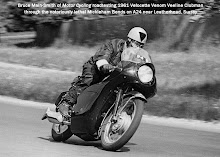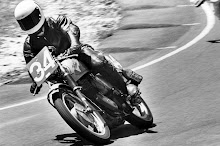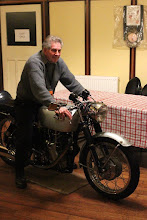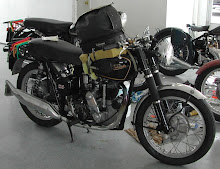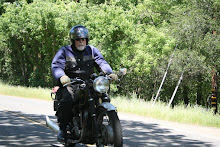To those who have followed my blog, you will know that I ran a motorcycle instrumentation business for over 25 years with a retail and wholesale bent.
These days I supply, worldwide, the trade and some selected people with special racing tachometers and associated parts.
I'm going to cover the aspect of drive gearboxes over several blogs, starting in this one with drive gearboxes to suit tachometers, with a heavy emphasis on motorcycles, but the reality is they equally apply to racing cars and racing boats.
Smiths, the UK company, now no longer involved in motorcycle and automotive instrumentation, is the basis of this blog and to them I acknowledge use of items from the many catalogues of theirs I have accumulated over the years and from which I want to share information with you.
Basically there are three major drive types, with a fourth, used in an application for one motorcycle and model.
1. Bronze drive type 70549 and 70549/-.
The bronze bodied drive, which I cannot be sure exactly when they were introduced, likely 1938, and were in the 1939 Smiths catalogue, used the bronze material as the bearing material for the driver and driven shafts which had the helical pattern gears on them.
This gear drive uses the same centre to centre distance for the gears meshing as does the later BG1507 type, but NOT the same as the BG1508 type. They appear to have been in production until around 1958 and were used as standard equipment on KTT Mk.7 and Mk.8 KTT Velocette racers, Norton Manx racers until 1954, AJS 7R racers until 1954, and BSA in their Gold Star range until 1958. Near the end of production the code numbering was changed to BG1506/--.
There were several variations on the plugs used to keep the gears in the drive. Sometimes a friction push fit, prone to pop out in use, letting the gear fall out on the road and get covered in sand and be lost from sight forever!
Another used wire circlips in grooves to keep the plugs in place, a better solution. There was a small grease nipple on the plug on the driver gear sometimes....
The 1-1 ratio used 11T on both driver and driven gears.
The 2-1 ratio used 8T driver and 16T driven gears.
2. The diecast bodied BG1508 series drive, which had phosphor bronze bushes for both driver and driven gearshafts to drive on.The plugs to secure these gears were just a tight push fit and again these frequently popped out in use, propelling the gear out, lost forever....
The code for this drive is stamped on the flange in the lower position in very small, around 1/16" high numerals.... inititially there was one code for the 1-1 and 2-1 versions, but then an oil retaining scroll was introduced onto the shaft and these ran in two opposite spirals, depending on the direction the driver gear went in an often not successful attempt to keep oil from exuding from out of the gearbox in service and so a new additional pair of codes were introduced.
The drive was introduced from around 1958 and continued until Smiths ceased production of motorcycle instruments around 1980.
They were standard equipment for Norton Commando etc....
A version of this drive, identical, but with the code BG1301/-- was used on certain car applications, for example the 1958 Jaguar series 1 ( Inspector Morse of TV fame used this body shaped car....)
The gear combinations for this drive are...
1-1 ratio , two 10 teeth helical gears.
2-1 ratio, an 8T driver and a 16T driven gear.
3. The cast aluminium bodied BG1507/-- drive with two ball race bearings on the input/driver shaft, with the output gear/driven shaft running in a phosphor bronze bush.
NOTE...this bush is cast into the drive when it is made and it has a locking collar somewhere along its length, so you can't drift out/press out the bush to replace it.... be warned.
The driven gear is secured with a cap, held in by a split pin. On this cap is stamped the code number...BG1507/--
This gearbox was originally called a type 70521 series drive, then changed around 1956 to BG1507 series numbering.
A special version, not usually shown on Smiths catalogues of this drive, is the BG1507/01 with a longer input shaft and used for 1956 onwards Manx Nortons.
These drives were painted externally black for the reversing types and a light brown for the non reversing type.
The use of ball races on the input shaft means this drive can be used with high rpm on the input gear...so often these drives are driven directly from an engine crankshaft...
Cotton Telstar, Greeves Silverstone, Aermacchi and Bultaco TSS racers to name a few.
A bronze bush is not happy using higher than around 3500rpm rotating in it, so the bronze 70549/BG1506 and BG1508 type gearboxes should NOT be used on these racers....
There was never a 1-1 ratio drive in this series ( I ,however make 1-1 reversing and non reversing versions of this drive).
The 2-1 ratio drive used 8T driver and 16T driven,
The 4-1 ratio drive used 4T driver and 16T driven.
The 8-1 ratio drive used 2T driver and 16T driven.
One of the most important items to ascertain when you require a drive, is to know the ratio of the tachometer you are using and the reduction, if any at the POINT OF DRIVE of the tacho drive gearbox.
If you drive from a magneto, then there will be a 2-1 reduction already, so a 2-1 tacho set-up needs no further reduction and a 1-1 tacho drive needed.
Conversly a 4-1 tacho in this situation needs a 2-1 drive gearbox.
2-1 times 2-1 = 4-1....
If the tacho requires the spinning cable end that goes into the tacho to be clockwise and this would be the case on a magnetic tacho that has a dial scale that advances in a clockwise direction...care here, as chrono tachos ALL have a clockwise advancing dial scale, but could have a small internal ( not visible) idler gear to reverse the cable direction... the tacho is called a clockwise tacho and an anticlockwise spinning cable needs normally an anticlockwise tacho.
You need to look at the point of drive.......
Does it go clockwise or anticlockwise......
Magnetos on British bikes almost always rotate anticlockwise at this point of drive.....
an exception is the Vincent motorcycle, whose point of drive is clockwise.
 So if your tacho is what we call a clockwise tacho and say 4-1 ratio, and your point of drive is a magneto and anticlockwise rotation, then you need to reverse the direction of the cable and give it another 2-1 reduction.
You need a 2-1 reversing tachometer drive gearbox.
From the charts on the following posted items, this would be a bronze 70549 2-1, a BG1508/01 or BG1508/06 or a BG1507/02.......
Left click on all the images to enlarge.......
So if your tacho is what we call a clockwise tacho and say 4-1 ratio, and your point of drive is a magneto and anticlockwise rotation, then you need to reverse the direction of the cable and give it another 2-1 reduction.
You need a 2-1 reversing tachometer drive gearbox.
From the charts on the following posted items, this would be a bronze 70549 2-1, a BG1508/01 or BG1508/06 or a BG1507/02.......
Left click on all the images to enlarge.......





 I said there was another special use Smiths drive..
I said there was another special use Smiths drive...it was used on pre unit construction Triumph 500cc twin road motorcycles and supplied with the special race kit for them and of course for the limited production Triumph GP racers,
It replaced the Lucas generator and being supplied with a 25T gear, engaged in mesh with the timing chest gear train.
As this point of drive was at crankshaft speed, the special tacho drive was 2-1 non reversing and required a 2-1 clockwise chronometric tachometer.
I still manufacture these drives.
All of the drives use a 1/2" x 26TPI whitworth form thread for the cable to attach to.
All of the drives use a slotted end on the driven cable for a special drive spade, supplied on the tachometer drive cable to engage with.
The BG1301/-- series sometimes used an internal square drive, as per the motorcycle speedometer cable type, on the driver/output shaft.

Type 70549 series that I continue to manufacture....

Type BG1507 series that I manufacture...

I do not make the diecast BG1508 series, but I do supply replacement gears for these and can supply the type 70549 series, normally bronze, but in cast aluminium as a good "look a like " replacement for the BG1508 series.
A page from the 1939 Smiths catalogue....
























































